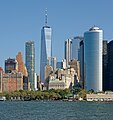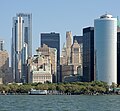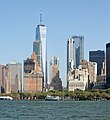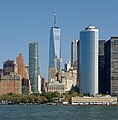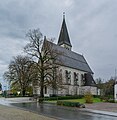Commons:Quality images candidates/Archives December 15 2023
-
- Nomination Peninsula promenade and Parkhotel, Pörtschach, Carinthia, Austria -- Johann Jaritz 04:11, 13 December 2023 (UTC)
- Promotion
 Support Good quality. --Jakubhal 04:44, 13 December 2023 (UTC)
Support Good quality. --Jakubhal 04:44, 13 December 2023 (UTC)
-
- Nomination Nativity scenes at the gazebo on Landspitz of the peninsula, Pörtschach, Carinthia, Austria -- Johann Jaritz 04:11, 13 December 2023 (UTC)
- Promotion
 Support Good quality. --Jakubhal 04:44, 13 December 2023 (UTC)
Support Good quality. --Jakubhal 04:44, 13 December 2023 (UTC)
-
- Nomination Lantern at the peninsula promenade, Pörtschach, Carinthia, Austria -- Johann Jaritz 04:11, 13 December 2023 (UTC)
- Promotion
 Support Good quality. --Jakubhal 04:45, 13 December 2023 (UTC)
Support Good quality. --Jakubhal 04:45, 13 December 2023 (UTC)
-
- Nomination Apartment building on 10.-Oktober-Straße #6, Pörtschach, Carinthia, Austria -- Johann Jaritz 04:11, 13 December 2023 (UTC)
- Promotion
 Support Good quality. --Jakubhal 04:46, 13 December 2023 (UTC)
Support Good quality. --Jakubhal 04:46, 13 December 2023 (UTC)
-
- Nomination Vacation home on Moosburger Straße #13, Pörtschach, Carinthia, Austria -- Johann Jaritz 04:11, 13 December 2023 (UTC)
- Promotion
 Support Good quality. --Jakubhal 04:46, 13 December 2023 (UTC)
Support Good quality. --Jakubhal 04:46, 13 December 2023 (UTC)
-
- Nomination Coat of arms of Rev. Anton Bodson at former rectory (1765) Saarburger Straße 1 in Konz-Könen, Germany. --Palauenc05 18:14, 12 December 2023 (UTC)
- Promotion
 Support Good quality.--Famberhorst 18:47, 12 December 2023 (UTC)
Support Good quality.--Famberhorst 18:47, 12 December 2023 (UTC)
-
- Nomination Inn sign of Tilman Riemenschneider Hotel, Rothenburg ob der Tauber, Germany --Poco a poco 18:01, 12 December 2023 (UTC)
- Promotion
 Support Good quality.--Famberhorst 18:04, 12 December 2023 (UTC)
Support Good quality.--Famberhorst 18:04, 12 December 2023 (UTC)
-
- Nomination Organ pipe, church of St Stephan, Germany --Poco a poco 18:01, 12 December 2023 (UTC)
- Promotion
 Support Good quality.--Famberhorst 18:07, 12 December 2023 (UTC)
Support Good quality.--Famberhorst 18:07, 12 December 2023 (UTC)
-
- Nomination Sieber Tower, Rothenburg ob der Tauber, Germany --Poco a poco 18:01, 12 December 2023 (UTC)
- Promotion
 Support Good quality. --Ermell 21:26, 12 December 2023 (UTC)
Support Good quality. --Ermell 21:26, 12 December 2023 (UTC)
-
- Nomination Canada Goose on the Connecticut River, East Hartford, CT USA --Pdanese 17:37, 12 December 2023 (UTC)
- Promotion
 Support Good quality. --Charlesjsharp 17:49, 12 December 2023 (UTC)
Support Good quality. --Charlesjsharp 17:49, 12 December 2023 (UTC)
-
- Nomination Micro garden in Linz --MB-one 17:17, 12 December 2023 (UTC)
- Promotion
 Support Good quality. --Poco a poco 18:55, 12 December 2023 (UTC)
Support Good quality. --Poco a poco 18:55, 12 December 2023 (UTC)
-
- Nomination Zanskar River between Hanumil and Pidmo / Ladakh, India --Imehling 16:33, 12 December 2023 (UTC)
- Promotion
 Support Good quality. --Poco a poco 18:55, 12 December 2023 (UTC)
Support Good quality. --Poco a poco 18:55, 12 December 2023 (UTC)
-
- Nomination Zanskar Trek - Hanuma La / Ladakh, India --Imehling 16:33, 12 December 2023 (UTC)
- Promotion
 Support Good quality. --Poco a poco 18:55, 12 December 2023 (UTC)
Support Good quality. --Poco a poco 18:55, 12 December 2023 (UTC)
-
- Nomination A Village lady holding 'Hasiya' from Shambhunath, NepalI, the copyright holder of this work, hereby publish it under the following license: --Suyash.dwivedi 15:54, 12 December 2023 (UTC)
- Decline
 Oppose Unsharp, sorry, Suyash, not a QI to me --Poco a poco 19:01, 12 December 2023 (UTC)
Oppose Unsharp, sorry, Suyash, not a QI to me --Poco a poco 19:01, 12 December 2023 (UTC)
-
- Nomination Candle in the Wallfahrtskirche Steinhausen --Kritzolina 15:23, 12 December 2023 (UTC)
- Promotion
 Support Good quality. Tighter crop at the top would be better IMO. --Ermell 21:42, 12 December 2023 (UTC)
Support Good quality. Tighter crop at the top would be better IMO. --Ermell 21:42, 12 December 2023 (UTC)
-
- Nomination BBL-Pokal (BBL Cup) 2023/24, Quarter-Final, Stadthalle Weißenfels: Syntainics MBC vs. ALBA Berlin (70:85) – Tom Scheunemann (MDR) --Sandro Halank 14:55, 12 December 2023 (UTC)
- Promotion
 Support Good quality. --Poco a poco 19:01, 12 December 2023 (UTC)
Support Good quality. --Poco a poco 19:01, 12 December 2023 (UTC)
-
- Nomination BBL-Pokal (BBL Cup) 2023/24, Quarter-Final, Stadthalle Weißenfels: Syntainics MBC vs. ALBA Berlin (70:85) – Louis Olinde (ALBA Berlin) --Sandro Halank 14:55, 12 December 2023 (UTC)
- Promotion
 Support Good quality. --Ermell 21:40, 12 December 2023 (UTC)
Support Good quality. --Ermell 21:40, 12 December 2023 (UTC)
-
- Nomination BBL-Pokal (BBL Cup) 2023/24, Quarter-Final, Stadthalle Weißenfels: Syntainics MBC vs. ALBA Berlin (70:85) – Žiga Samar (ALBA Berlin) --Sandro Halank 14:55, 12 December 2023 (UTC)
- Promotion
 Support Good quality. --Poco a poco 19:01, 12 December 2023 (UTC)
Support Good quality. --Poco a poco 19:01, 12 December 2023 (UTC)
-
- Nomination BBL-Pokal (BBL Cup) 2023/24, Quarter-Final, Stadthalle Weißenfels: Syntainics MBC vs. ALBA Berlin (70:85) – Sterling Brown (ALBA Berlin) --Sandro Halank 14:55, 12 December 2023 (UTC)
- Promotion
 Support Good quality. --Poco a poco 19:01, 12 December 2023 (UTC)
Support Good quality. --Poco a poco 19:01, 12 December 2023 (UTC)
-
- Nomination BBL-Pokal (BBL Cup) 2023/24, Quarter-Final, Stadthalle Weißenfels: Syntainics MBC vs. ALBA Berlin (70:85) – Himar Ojeda (ALBA Berlin) --Sandro Halank 14:55, 12 December 2023 (UTC)
- Promotion
 Support Good quality. --Ermell 21:41, 12 December 2023 (UTC)
Support Good quality. --Ermell 21:41, 12 December 2023 (UTC)
-
- Nomination Island Dzharylhach. By User:Ryzhkov Oleksandr --Anntinomy 13:56, 12 December 2023 (UTC)
- Promotion Good, da. --PetarM 14:01, 12 December 2023 (UTC)
-
- Nomination Novyi Svit Sanctuary. By User:Ryzhkov Oleksandr --Anntinomy 13:56, 12 December 2023 (UTC)
- Decline Very noisy picture if you'll zoom in even to a "full monitor" scale. Appreciated the composition tho. --Красный 14:41, 12 December 2023 (UTC)
-
- Nomination Novyi Svit Sanctuary. By User:Ryzhkov Oleksandr --Anntinomy 13:56, 12 December 2023 (UTC)
- Promotion This one is a much less noisy, so ok for me as a night photo. Cool shot! --Красный 14:41, 12 December 2023 (UTC)
-
- Nomination Sednivskyi reserve. By User:Alex Arendar --Anntinomy 13:56, 12 December 2023 (UTC)
- Promotion
 Support Good quality. --Poco a poco 19:17, 12 December 2023 (UTC)
Support Good quality. --Poco a poco 19:17, 12 December 2023 (UTC)
-
- Nomination Centhron at e-tropolis 2015, Oberhausen, by Achim Raschka. --Smial 13:44, 12 December 2023 (UTC)
- Promotion
 Support Good quality. --Ermell 13:51, 12 December 2023 (UTC)
Support Good quality. --Ermell 13:51, 12 December 2023 (UTC)
-
- Nomination Pupa of Open wing Dorsal view of Acraea issoria (Hübner, 1819) - Yellow Coster. By User:SVKMBFLY --Atudu 13:43, 12 December 2023 (UTC)
- Promotion
 Support Good quality. --Poco a poco 19:04, 12 December 2023 (UTC)
Support Good quality. --Poco a poco 19:04, 12 December 2023 (UTC)
-
- Nomination Offshore supply vessel Agnes Candies. --GuavaTrain 10:44, 12 December 2023 (UTC)
- Promotion
 Support Good quality. --Poco a poco 19:05, 12 December 2023 (UTC)
Support Good quality. --Poco a poco 19:05, 12 December 2023 (UTC)
-
- Nomination Aerial view of Rosenberg Fortress in Kronach --Ermell 09:10, 12 December 2023 (UTC)
- Promotion
 Support Good quality. --Mike1979 Russia 19:01, 12 December 2023 (UTC)
Support Good quality. --Mike1979 Russia 19:01, 12 December 2023 (UTC) Support Good quality. --Poco a poco 19:04, 12 December 2023 (UTC)
Support Good quality. --Poco a poco 19:04, 12 December 2023 (UTC)
-
- Nomination Litzendorf in the district of Bamberg, aerial view. --Ermell 09:10, 12 December 2023 (UTC)
- Promotion
 Support Good quality.--Famberhorst 18:01, 12 December 2023 (UTC)
Support Good quality.--Famberhorst 18:01, 12 December 2023 (UTC)
-
- Nomination Funeral parlour at the Fasanerie cemetery in Memmelsdorf --Ermell 09:10, 12 December 2023 (UTC)
- Promotion
 Support Good quality.--Famberhorst 18:03, 12 December 2023 (UTC)
Support Good quality.--Famberhorst 18:03, 12 December 2023 (UTC)
-
- Nomination Footbridge, called HolKa, over the Vltava River in Prague. --PetrVod 08:56, 12 December 2023 (UTC)
- Promotion
 Support Good quality. --Poco a poco 19:04, 12 December 2023 (UTC)
Support Good quality. --Poco a poco 19:04, 12 December 2023 (UTC)
-
- Nomination Close wing Nectaring of Appias olferna Swinhoe, 1890 - Eastern Striped Albatross (Male) --Sandipoutsider 20:56, 12 December 2023 (UTC)
- Decline Insufficient quality: low detail level. --Peulle 08:46, 12 December 2023 (UTC)
-
- Nomination Bolsa do Café, Santos, Brazil --Mike Peel 07:23, 12 December 2023 (UTC)
- Promotion
 Support Good quality. --Poco a poco 19:05, 12 December 2023 (UTC)
Support Good quality. --Poco a poco 19:05, 12 December 2023 (UTC)
-
- Nomination Eagle sculpture on top of the Theatro Municipal, Rio de Janeiro --Mike Peel 07:23, 12 December 2023 (UTC)
- Promotion
 Support Good quality. --Poco a poco 19:04, 12 December 2023 (UTC)
Support Good quality. --Poco a poco 19:04, 12 December 2023 (UTC) Support Good quality. --Mike1979 Russia 19:06, 12 December 2023 (UTC)
Support Good quality. --Mike1979 Russia 19:06, 12 December 2023 (UTC)
-
- Nomination Close wing Basking posture of Leptosia nina (Fabricius, 1793) - Psyche --Sandipoutsider 20:48, 12 December 2023 (UTC)
- Promotion
 Support Good quality. --Ermell 13:52, 12 December 2023 (UTC)
Support Good quality. --Ermell 13:52, 12 December 2023 (UTC)
-
- Nomination Open wing leaf top Basking posture of Athyma perius (Linnaeus, 1758) - Common Sergeant --Sandipoutsider 20:42, 12 December 2023 (UTC)
- Promotion
 Support Good quality. --Ermell 13:52, 12 December 2023 (UTC)
Support Good quality. --Ermell 13:52, 12 December 2023 (UTC)
-
- Nomination Close wing Basking of Chilades lajus (Stoll, 1780) - Lime Blues --Sandipoutsider 20:38, 12 December 2023 (UTC)
- Decline
 Oppose head not in focus. --Charlesjsharp 17:52, 12 December 2023 (UTC)
Oppose head not in focus. --Charlesjsharp 17:52, 12 December 2023 (UTC)
-
- Nomination Aachen-NRW, churchtower (Sankt-Folian Kirche) from Münsterplatz --Michielverbeek 06:44, 12 December 2023 (UTC)
- Promotion
 Support Good quality. --Johann Jaritz 06:51, 12 December 2023 (UTC)
Support Good quality. --Johann Jaritz 06:51, 12 December 2023 (UTC)
-
- Nomination Aachen-NRW, the Aachener Dom - the neo-Gothic bell tower from the Rennbahn --Michielverbeek 06:44, 12 December 2023 (UTC)
- Promotion
 Support Good quality.--Famberhorst 17:56, 12 December 2023 (UTC)
Support Good quality.--Famberhorst 17:56, 12 December 2023 (UTC)
-
- Nomination Aachen-NRW, the Aachener Dom - the neo-Gothic bell tower from Anna Strasse --Michielverbeek 06:44, 12 December 2023 (UTC)
- Promotion
 Support Good quality. --Ermell 09:02, 12 December 2023 (UTC)
Support Good quality. --Ermell 09:02, 12 December 2023 (UTC)
-
- Nomination Aachen-NRW, Theater Aachen --Michielverbeek 06:44, 12 December 2023 (UTC)
- Promotion
 Support Good quality. --Johann Jaritz 06:51, 12 December 2023 (UTC)
Support Good quality. --Johann Jaritz 06:51, 12 December 2023 (UTC)
-
- Nomination Interior of the Hundinghütte, Garden Linderhof Palace, Bavaria --Llez 06:30, 12 December 2023 (UTC)
- Promotion
 Support Good quality. --Johann Jaritz 06:52, 12 December 2023 (UTC)
Support Good quality. --Johann Jaritz 06:52, 12 December 2023 (UTC)
-
- Nomination Interior of the Hundinghütte, Garden Linderhof Palace, Bavaria --Llez 06:30, 12 December 2023 (UTC)
- Promotion
 Support Good quality.--Famberhorst 17:55, 12 December 2023 (UTC)
Support Good quality.--Famberhorst 17:55, 12 December 2023 (UTC)
-
- Nomination Left valve of a European Bearded Ark, Barbatia barbata var. elongata --Llez 06:30, 12 December 2023 (UTC)
- Promotion
 Support Good quality. --Johann Jaritz 06:52, 12 December 2023 (UTC)
Support Good quality. --Johann Jaritz 06:52, 12 December 2023 (UTC)
-
- Nomination View of Manhattan from Circle Line Sightseeing boat, New York City --Jakubhal 05:28, 12 December 2023 (UTC)
- Promotion
 Support Good quality. --Johann Jaritz 05:40, 12 December 2023 (UTC)
Support Good quality. --Johann Jaritz 05:40, 12 December 2023 (UTC)
-
- Nomination View of Manhattan from Circle Line Sightseeing boat, New York City --Jakubhal 05:28, 12 December 2023 (UTC)
- Promotion
 Support Good quality. --Johann Jaritz 05:40, 12 December 2023 (UTC)
Support Good quality. --Johann Jaritz 05:40, 12 December 2023 (UTC)
-
- Nomination View of Manhattan from Circle Line Sightseeing boat, New York City --Jakubhal 05:28, 12 December 2023 (UTC)
- Promotion
 Support Good quality. --Johann Jaritz 05:40, 12 December 2023 (UTC)
Support Good quality. --Johann Jaritz 05:40, 12 December 2023 (UTC)
-
- Nomination View of Manhattan from Circle Line Sightseeing boat, New York City --Jakubhal 05:28, 12 December 2023 (UTC)
- Promotion
 Support Good quality. --Johann Jaritz 05:40, 12 December 2023 (UTC)
Support Good quality. --Johann Jaritz 05:40, 12 December 2023 (UTC)
-
- Nomination View of Manhattan from Circle Line Sightseeing boat, East River, New York City --Jakubhal 05:28, 12 December 2023 (UTC)
- Promotion
 Support Good quality. --Johann Jaritz 05:40, 12 December 2023 (UTC)
Support Good quality. --Johann Jaritz 05:40, 12 December 2023 (UTC)
-
- Nomination Atypical chess pieces, probably made in Indonesia. --Tournasol7 05:09, 12 December 2023 (UTC)
- Promotion
 Support Good quality. --Jakubhal 05:29, 12 December 2023 (UTC)
Support Good quality. --Jakubhal 05:29, 12 December 2023 (UTC)
-
- Nomination Parish church in Ruggell, Unterland, Liechtenstein. --Tournasol7 05:09, 12 December 2023 (UTC)
- Promotion
 Support Good quality. --Jakubhal 05:29, 12 December 2023 (UTC)
Support Good quality. --Jakubhal 05:29, 12 December 2023 (UTC)
-
- Nomination Parish church in Ruggell, Unterland, Liechtenstein. --Tournasol7 05:09, 12 December 2023 (UTC)
- Promotion
 Support Good quality. --Jakubhal 05:30, 12 December 2023 (UTC)
Support Good quality. --Jakubhal 05:30, 12 December 2023 (UTC)
-
- Nomination Parish church in Ruggell, Unterland, Liechtenstein. --Tournasol7 05:09, 12 December 2023 (UTC)
- Promotion Good quality --Jakubhal 05:31, 12 December 2023 (UTC)
-
- Nomination Parish church in Ruggell, Unterland, Liechtenstein. --Tournasol7 05:09, 12 December 2023 (UTC)
- Promotion Good quality --Jakubhal 05:31, 12 December 2023 (UTC)
-
- Nomination 15th century "Chicken's Stone" north of Oberhaid --Plozessor 04:51, 12 December 2023 (UTC)
- Promotion
 Support Good quality.--Tournasol7 05:13, 12 December 2023 (UTC)
Support Good quality.--Tournasol7 05:13, 12 December 2023 (UTC)
-
- Nomination Grave of poet Georg Stubenrauch --Plozessor 04:51, 12 December 2023 (UTC)
- Promotion
the shadows are removed too much, which gives an unnatural impression on this photo. --Tournasol7 05:18, 12 December 2023 (UTC)
@Tournasol7 Not sure, the stone has an unusual contrast in reality. Anyway, uploaded a new version, please check that out. --Plozessor 06:45, 12 December 2023 (UTC)
It's a fact - sometimes it's difficult to take photos of objects in the shade. It seems better to me now. Thank you. --Tournasol7 14:42, 12 December 2023 (UTC)
-
- Nomination Natural monument "Cellar Oak" in Rotenhan --Plozessor 04:51, 12 December 2023 (UTC)
- Promotion
 Support Good quality.--Tournasol7 05:14, 12 December 2023 (UTC)
Support Good quality.--Tournasol7 05:14, 12 December 2023 (UTC)
-
- Nomination Statues of the Bogengalerie in the Zwinger in Dresden, Saxony, Germany --XRay 04:43, 12 December 2023 (UTC)
- Promotion
 Support Good quality.--Tournasol7 05:14, 12 December 2023 (UTC)
Support Good quality.--Tournasol7 05:14, 12 December 2023 (UTC)
-
- Nomination Christmas tree decorations in the Altmarkt-Galerie (photographed using ICM technology) in Dresden, Saxony, Germany --XRay 04:43, 12 December 2023 (UTC)
- Promotion
 Support Good quality. --Johann Jaritz 05:39, 12 December 2023 (UTC)
Support Good quality. --Johann Jaritz 05:39, 12 December 2023 (UTC)
-
- Nomination Close Wing Basking of Chilades pandava (Horsfield, 1829) - Plains CupidThis image was uploaded as part of Wiki Loves Butterfly. --TAPAN1412 02:06, 12 December 2023 (UTC)
- Decline
 Oppose insufficient detail --Charlesjsharp 17:53, 12 December 2023 (UTC)
Oppose insufficient detail --Charlesjsharp 17:53, 12 December 2023 (UTC)
-
- Nomination Open Wing Basking of Symphaedra nais (Forster, 1771) - Baronet --TAPAN1412 01:59, 12 December 2023 (UTC)
- Decline
Blurry and noisy. Fixable? --Tagooty 03:20, 12 December 2023 (UTC) Oppose well short of QI --Charlesjsharp 17:54, 12 December 2023 (UTC)
Oppose well short of QI --Charlesjsharp 17:54, 12 December 2023 (UTC)
-
- Nomination The Bourtzi of Karystos. --C messier 20:58, 11 December 2023 (UTC)
- Promotion
 Support Good quality. --Mike1979 Russia 19:02, 12 December 2023 (UTC)
Support Good quality. --Mike1979 Russia 19:02, 12 December 2023 (UTC)
-
- Nomination BMW 3.0 CSi at Solitude Revival 2022 --Alexander-93 20:19, 11 December 2023 (UTC)
- Promotion Good quality. --Smial 13:15, 12 December 2023 (UTC)
-
- Nomination De Tomaso Pantera (1971) at Solitude Revival 2022 --Alexander-93 20:19, 11 December 2023 (UTC)
- Promotion
 Support Good quality. --Plozessor 07:31, 12 December 2023 (UTC)
Support Good quality. --Plozessor 07:31, 12 December 2023 (UTC)
-
- Nomination De Tomaso Pantera GTS (1982) at Solitude Revival 2022 --Alexander-93 20:19, 11 December 2023 (UTC)
- Promotion Good quality. --Smial 13:15, 12 December 2023 (UTC)
-
- Nomination Pavillion in court of Soma Gompa in Leh / Ladakh, India --Imehling 16:37, 11 December 2023 (UTC)
- Promotion
There is some cw tilt --Poco a poco 18:43, 11 December 2023 (UTC) Done --Imehling 16:28, 12 December 2023 (UTC)
Done --Imehling 16:28, 12 December 2023 (UTC) Support Good quality. --Poco a poco 19:31, 12 December 2023 (UTC)
Support Good quality. --Poco a poco 19:31, 12 December 2023 (UTC)
-
- Nomination: Honda ZR-V e-HEV at Auto Zuerich 2023 --Alexander-93 18:38, 6 December 2023 (UTC)
- Review needed
-
- Nomination: Mycenean town of Chalandritsa. --C messier 17:45, 6 December 2023 (UTC)
- Review
It needs a perspective correction --Poco a poco 19:20, 6 December 2023 (UTC)
-
- Nomination: Panoramic view of Wielmoża village, Poland. By User:Przykuta --Mechanik rowerowy 15:18, 6 December 2023 (UTC)
- Review needed
-
- Nomination: Barracks in Wielmoża, Poland. By User:Przykuta --Mechanik rowerowy 15:18, 6 December 2023 (UTC)
- Review needed
-
- Nomination: Phở bò served in a restaurant in Germany --Kritzolina 10:56, 6 December 2023 (UTC)
- Review needed
-
- Nomination: Frozen water in a rainwater barrel with leaves in winter --Kritzolina 10:56, 6 December 2023 (UTC)
- Review needed
-
- Nomination: "Privat", the German word for "private" painted on asphalt --Kritzolina 10:56, 6 December 2023 (UTC)
- Review needed
-
- Nomination: Common dots (Micropentila adelgitha) --Charlesjsharp 09:07, 6 December 2023 (UTC)
- Review needed
-
- Nomination: Steenwijk-NL, sculpture near the library - de Landarbeidster (the farm worker) --Michielverbeek 05:56, 6 December 2023 (UTC)
- Review needed
-
- Nomination: Long Jump at the Men's Decathlon at the European Athletics Championships during the European Championships Munich 2022: Marcus Nilsson, Sweden --Sandro Halank 19:56, 5 December 2023 (UTC)
- Review
these four nominations seem overexposed --Charlesjsharp 09:05, 6 December 2023 (UTC)
-
- Nomination: Tophane Fountain, Istanbul, Turkey --Another Believer 18:10, 5 December 2023 (UTC)
- Review
At least would need PC and a better filename. Also could be slightly sharper. --Plozessor 06:44, 6 December 2023 (UTC)
-
- Nomination: Cat on a car in Balat, Istanbul, Turkey --Another Believer 18:10, 5 December 2023 (UTC)
- Review
Unfortunately the cat, who is supposed to be the subject, is a bit blurry. Also there are halos around the flags. And the filename is too generic. --Plozessor 06:44, 6 December 2023 (UTC)
-
- Nomination Allegory of Rhône river statue --Romainbehar 20:19, 4 December 2023 (UTC)
- Promotion
 Support Good quality. --C messier 22:14, 12 December 2023 (UTC)
Support Good quality. --C messier 22:14, 12 December 2023 (UTC)
-
- Nomination Lexus RZ 450e (XEBM15) at Auto Zuerich 2023 --Alexander-93 18:13, 4 December 2023 (UTC)
- Promotion
 Support Good quality. --C messier 22:14, 12 December 2023 (UTC)
Support Good quality. --C messier 22:14, 12 December 2023 (UTC)
-
- Nomination Footbridge over the Mzymta river in Rosa Khutor Alpine Resort. --Alexander Novikov 11:18, 4 December 2023 (UTC)
- Promotion
 Support On the noisy side but still ok. --MB-one 17:25, 12 December 2023 (UTC)
Support On the noisy side but still ok. --MB-one 17:25, 12 December 2023 (UTC)
-
- Nomination Ruin of the manor in Konarzewo. By User:Przykuta --Mechanik rowerowy 09:29, 4 December 2023 (UTC)
- Decline
 Oppose Too soft. Also perspective correction needed --MB-one 17:25, 12 December 2023 (UTC)
Oppose Too soft. Also perspective correction needed --MB-one 17:25, 12 December 2023 (UTC)
-
- Nomination Carriage house in Kierpajny Wielkie - detail. By User:Przykuta --Mechanik rowerowy 09:34, 27 November 2023 (UTC)
- Decline
A bit tilted counter clock wise. --C messier 20:34, 5 December 2023 (UTC) Not done in a week. --C messier 22:16, 12 December 2023 (UTC)
Not done in a week. --C messier 22:16, 12 December 2023 (UTC)
-
- Nomination Center of Lelkowo, Poland. By User:Przykuta --Mechanik rowerowy 09:34, 27 November 2023 (UTC)
- Decline
Stiching errors, quite small too. --C messier 20:34, 5 December 2023 (UTC) Not done in a week. --C messier 22:16, 12 December 2023 (UTC)
Not done in a week. --C messier 22:16, 12 December 2023 (UTC)
-
- Nomination Close Wing Nectaring of Pachliopta aristolochiae (Fabricius, 1775) - Common RoseThis image was uploaded as part of Wiki Loves Butterfly.--TAPAN1412 04:12, 24 November 2023 (UTC)
- Decline
Noisy but fixable --Gugalcrom123 15:19, 29 November 2023 (UTC)
Can halo artifacts surrounding the wings be fixed?. --Tiouraren 12:06, 5 December 2023 (UTC) Oppose
Oppose  Not done --Plozessor 14:30, 12 December 2023 (UTC)
Not done --Plozessor 14:30, 12 December 2023 (UTC)
Consensual review edit
File:2022_July_-_JawaharKalaKendra_Jaipur_12_(cropped).jpg edit
- Nomination JawaharKalaKendra, Jaipur --Chainwit. 19:56, 10 December 2023 (UTC)
- Decline
- Support Good quality, interesting shadow -- Spurzem 22:09, 10 December 2023 (UTC)
- Oppose Very small for a picture of stationary object, below 2MP --Jakubhal 19:45, 11 December 2023 (UTC)
- Oppose Less than 2 MP. --Plozessor 08:14, 12 December 2023 (UTC)
- Oppose less than 2 MP --Sandro Halank 14:57, 12 December 2023 (UTC)
Total: 1 support (excluding the nominator), 3 oppose → Declined --Robert Flogaus-Faust 21:06, 14 December 2023 (UTC)
File:Rosenbühler_Weg_20231201_HOF02793_RAW-Export.png edit
- Nomination Rosenbühl path in snow in Hof, Germany. --PantheraLeo1359531 18:43, 1 December 2023 (UTC)
- Promotion
- Comment Is it possible for you to use jpg format? 88 MB for a picture of this size is way over the top. --Imehling 10:13, 8 December 2023 (UTC)
- Info I decided to go to PNG because it allows the best opportunity to have a good editing scope. PNG offers better color gradients in image than the JPEG compression for example --PantheraLeo1359531 19:16, 8 December 2023 (UTC)
- Comment Interesting question. I would like to have a discussion about that. --Imehling 08:58, 9 December 2023 (UTC)
- Comment I'm pretty sure that there is no rule on Commons that would ban PNGs. Recently someone uploaded a giant TIFF file, and even that is allowed. My personal opinion is that PNG is good for the photographer's personal archive, but JPG in quality 11 (of 12) is good enough for export / publication. --Plozessor 09:01, 9 December 2023 (UTC)
- Comment Funfact: With irfanview converted to a JPG in the best quality setting and subsampling switched off, the photo is still about 55 MB in size. I then superimposed the two variants and offset them against each other, the result is... almost black. Only if you brighten this result drastically in GIMP shadowy differences become recognisable. The real mistake lies in saving PNG with only 8 bit colour depth per channel, thus combining the worst of both worlds: poor compression of PNG in photos with poor colour depth of JPG. If you really want to take advantage of PNG, you must use 16 bit colour depth per channel. Which of course makes the files considerably larger... --Smial 12:38, 10 December 2023 (UTC)
- When I switched to PNG, I took several points into account. I upload some files with 16 bits per channel for best representation in color gradients and upload a smaller file as new version in 8bit. PNG files are saved 1:1 as edited. With JPEG compression, the image is changed in appearance. Yes, "best quality" compression produces artifacts, that are barely visible. But they are there, especially in areas where the human eye does not see details easily. JPEG groups in 8x8 pixel fields and adds patterns to the image. PNG without these changes offers best editing preconditions. PNG as lossless compressed file indicates that the image is the original. Image sensors generate no perfect images, but tend to leave behind and add "sensor patterns" to images, better identifiable with exaggerating color curves afterwards. As they are not visible with typical settings to the visible eye, they may be changed after JPEG compression. The PNG 1:1 leaves as is and can prove authenticity and show that this image is real (especially in times of AI). Of course, some arguments can be questioned by other people, but I think PNG is better here, especially for historic purposes. There also may be differences in chroma subsampling and some more --PantheraLeo1359531 17:28, 10 December 2023 (UTC)
- And you can switch from this PNG to JPG at any time, if you wish. So you can choose between an original version and a smaller version :) --PantheraLeo1359531 17:30, 10 December 2023 (UTC)
- I did a lossless compression from a PNG to WebP (from 66.6 MiB to 43.7 MiB). This would be a fair deal. But WebP is not really popular --PantheraLeo1359531 17:34, 10 December 2023 (UTC)
- Comment Why don't you use 16-bit as a standard to achieve a really useful improvement over JPG? When it comes to authenticity, PNG does not have the slightest advantage over JPG, both are formats derived from the RAW format of the camera used, and the algorithms of the raw developers have considerably more influence, especially when interpolating the Bayer matrix, than the small difference between lossless PNG and "JPG in best quality" would make up. What the fighting term "AI" is supposed to prove is unclear to me, if I save artificially generated images as PNG, they are just as "authentic" as your PNG photos. Please don't misunderstand me, I accept your goodwill in wanting to offer a workaround for the weaknesses of the outdated 8-bit JPG format, I'm just trying to make it clear that 8-bit PNG only offers recognisable advantages over JPG if you approach it with forensic methods. Especially when it comes to contrast or brightness manipulation in digital post-processing, 8-bit PNG is just as shitty as 8-bit JPG. At best, RAW data would be truly authentic. --Smial 19:59, 10 December 2023 (UTC)
- And you can switch from this PNG to JPG at any time, if you wish. So you can choose between an original version and a smaller version :) --PantheraLeo1359531 17:30, 10 December 2023 (UTC)
- When I switched to PNG, I took several points into account. I upload some files with 16 bits per channel for best representation in color gradients and upload a smaller file as new version in 8bit. PNG files are saved 1:1 as edited. With JPEG compression, the image is changed in appearance. Yes, "best quality" compression produces artifacts, that are barely visible. But they are there, especially in areas where the human eye does not see details easily. JPEG groups in 8x8 pixel fields and adds patterns to the image. PNG without these changes offers best editing preconditions. PNG as lossless compressed file indicates that the image is the original. Image sensors generate no perfect images, but tend to leave behind and add "sensor patterns" to images, better identifiable with exaggerating color curves afterwards. As they are not visible with typical settings to the visible eye, they may be changed after JPEG compression. The PNG 1:1 leaves as is and can prove authenticity and show that this image is real (especially in times of AI). Of course, some arguments can be questioned by other people, but I think PNG is better here, especially for historic purposes. There also may be differences in chroma subsampling and some more --PantheraLeo1359531 17:28, 10 December 2023 (UTC)
- Support Reviewing the actual photo, (ahem ;-P ) I think it's a QI. --Peulle 13:08, 11 December 2023 (UTC)
- Support ja, sicher. --Smial 15:52, 11 December 2023 (UTC)
- Support Schon gut, aber ich sehe eigentlich keinen Grund dafür, die Datei so aufzublasen ohne wirklichen Qualitätsgewinn. --Imehling 16:28, 11 December 2023 (UTC)
Total: 3 support (excluding the nominator), 0 oppose → Promoted --Robert Flogaus-Faust 21:01, 14 December 2023 (UTC)


